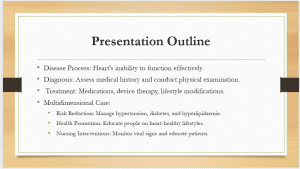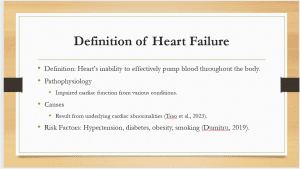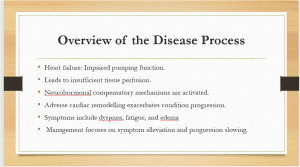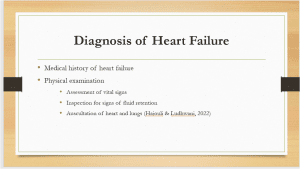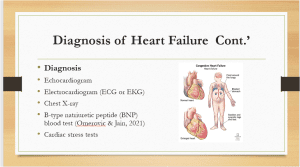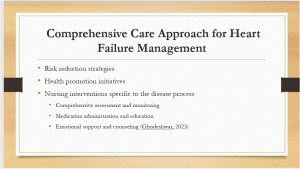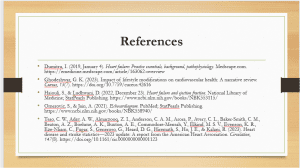Multidimensional Care for Heart Failure Patients – Risk Reduction, Health Promotion, and Nursing Interventions
Hello everyone. Today, we will look deeper into multidimensional care for heart failure patients. The main emphasis will be on the matters of risk reduction, health promotion, and nursing interventions. By dealing with the risk factors, encouraging healthy behaviors, and offering the nursing care that is suited to their individual needs, we can enhance the results and consequently the quality of life of these people.
Through this presentation, we will be discussing the importance of heart failure management. We will be discussing the mainstream prevalence and the effect, with a focus on the critical role of nurses. The diagnosis process will be carried out by conducting a thorough assessment and tests, and thereafter, the treatment modality like medications, lifestyle changes and interventions will be applied. Besides, we will underline the nursing field’s emphasis on the reduction of risk, health promotion, and collaboration with other members of the healthcare team for more comprehensive patient care.
Heart failure is a medical condition that is depicted by the heart’s incapability to properly pump blood to the whole body. This leads to inadequate circulation of oxygen-rich blood, which is needed to meet the body’s metabolic needs. Heart failure is caused by impaired cardiac function, which can be a result of different cardiac conditions or systemic conditions such as coronary artery disease, hypertension, myocardial infarction, valvular heart disease, or cardiomyopathy.
In the beginning, compensatory mechanisms like neurohormonal activation help maintain cardiac output. Nevertheless, these adaptive mechanisms transform into maladaptive ones, which, in turn, aggravate heart failure (Dumitru, 2019).
Heart failure is a complicated syndrome that makes the heart unable to pump enough blood for the body to meet its metabolic needs. This illness is mainly because of the heart’s hidden defects or the systemic conditions that change the structure or function of the heart. The most common causes that the disease is associated with are coronary artery disease, hypertension, myocardial infarction, valvular heart disease, and cardiomyopathy.
The insufficiency of the heart to pump blood effectively results from a sequence of events that cause the heart failure pathophysiology. The heart can repair its decreased function by activating neurohormonal mechanisms like the sympathetic nervous system and renin-angiotensin-aldosterone system, which is used to maintain cardiac output. Nevertheless, these compensatory mechanisms can lead to the harmful remodeling of the heart muscle and vasculature, thus aggravating heart failure even more.
As heart failure proceeds, the heart’s pumping capability continues to fall, leading to symptoms such as dyspnea, fatigue, edema and exercise intolerance. These problems are consequences of insufficient tissue perfusion and oxygenation, as well as fluid retaining caused by the kidneys’ inability to regulate the fluid in the body.
Besides, heart failure can cause damage to both the left and the right side of the heart, thus resulting in different clinical manifestations. Right-sided heart failure can be felt as peripheral edema and hepatic congestion, and left-sided heart failure can be seen as pulmonary congestion and the symptoms of pulmonary edema, such as dyspnea and coughing.
Healthcare professionals gather data about the patient’s symptoms, medical history and the risk factors for heart disease. They inquire about signs such as shortness of breath, fatigue, swelling, and exercise intolerance. They also review the patient’s medical history to find out if there are any pre-existing conditions or factors that may be the cause of heart failure, like hypertension, coronary artery disease, diabetes, or previous heart attacks (Hajouli & Ludhwani, 2022).
Further, a full physical examination is performed that checks for the signs of heart failure, for example, abnormal heart sounds (like mums), high jugular venous pressure, pulmonary crackles, and peripheral edema. The signs are the indicators of heart failure, and they show the severity and cause of the problem.
Various tests are used to confirm the diagnosis of heart failure and evaluate its underlying cause and severity. These tests may include:
- Echocardiogram: This ultrasound imaging test provides detailed images of the heart’s structure and function, allowing healthcare providers to assess cardiac function, identify structural abnormalities, and measure parameters such as ejection fraction (a measure of the heart’s pumping ability).
- Electrocardiogram (ECG or EKG): This non-invasive test records the heart’s electrical activity and can help detect abnormal rhythms (arrhythmias) and signs of previous heart damage(Omerovic & Jain, 2021).
- Chest X-ray: This imaging test helps assess the size and shape of the heart and detect signs of fluid accumulation in the lungs (pulmonary congestion) associated with heart failure.
- Cardiac stress tests: These tests assess the heart’s response to physical activity or pharmacological stress and can help diagnose coronary artery disease and evaluate cardiac function.
Risk reduction strategies include implementing measures to manage and mitigate factors that contribute to heart failure exacerbations, such as hypertension, diabetes, and hyperlipidemia. This may involve medication management, lifestyle modifications, and patient education to promote adherence to treatment regimens and healthy behaviors. On the other hand, health promotion initiatives include educating patients about heart-healthy lifestyles, including dietary modifications (like low-sodium diets), regular physical activity, smoking cessation, and stress management techniques. Empowering patients to take an active role in their care and make informed decisions regarding their health can improve outcomes and quality of life (Ghodeshwar, 2023).
Further, with nursing interventions specific to the disease process, nurses are the most important healthcare professionals when it comes to the care of patients with heart failure due to their ability to perform a complete assessment, monitoring, and management of the symptoms. The information here pertains to monitoring the vital signs, fluid status, and cardiac function, along with administering medications, such as diuretics and ACE inhibitors, as prescribed. Besides that, nurses also give patients information regarding medication adherence, dietary restrictions, symptom recognition, and self-care techniques. Emotional support and counseling are also crucial parts of nursing care, which help patients and families cope with the obstacles of heart failure and enforce the treatment plans. Working with a diverse healthcare team guarantees the patient receives the best care possible, and consequently, all cases are effectively managed.
ORDER A PLAGIARISM-FREE PAPER HERE
We’ll write everything from scratch
Question
Initial post
Pick one hematological disorder covered in this module. For this disorder, identify and describe three treatment strategies for the disorder.
Multidimensional Care for Heart Failure Patients – Risk Reduction, Health Promotion, and Nursing Interventions
What challenges could arise in carrying out these strategies and providing care to the patient?
AA
learning.rasmussen.edu


